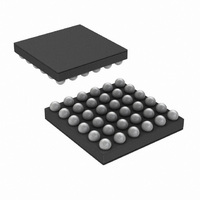LM49350RLX/NOPB National Semiconductor, LM49350RLX/NOPB Datasheet - Page 42

LM49350RLX/NOPB
Manufacturer Part Number
LM49350RLX/NOPB
Description
IC AUDIO SUBSYSTM .8W D 36USMDXT
Manufacturer
National Semiconductor
Series
Boomer®r
Type
Class Dr
Datasheet
1.LM49350RLNOPB.pdf
(104 pages)
Specifications of LM49350RLX/NOPB
Output Type
1-Channel (Mono) with Mono and Stereo Headphones
Max Output Power X Channels @ Load
2W x 1 @ 4 Ohm; 69mW x 2 @ 32 Ohm
Voltage - Supply
2.7 V ~ 5.5 V
Features
3D, DAC, Depop, I²C, I²S, Mute, Short-Circuit and Thermal Protection, Shutdown, Volume Control
Mounting Type
Surface Mount
Package / Case
36-MicroSMDxt
Lead Free Status / RoHS Status
Lead free / RoHS Compliant
Other names
LM49350RLX
www.national.com
20.0 Analog Mixer Control Registers
This register is used to control the LM49350's Analog Mixer:
20.1 CLASS D LOUDSPEAKER AMPLIFIER
The LM49350 features a filterless modulation scheme. The
differential outputs of the device switch at 300kHz from V
to GND. When there is no input signal applied, the two outputs
(LS+ and LS-) switch with a 50% duty cycle, with both outputs
in phase. Because the outputs of the LM49350 are differen-
tial, the two signals cancel each other. This results in no net
voltage across the speaker, thus there is no load current dur-
ing an idle state, conserving power.
With an input signal applied, the duty cycle (pulse width) of
the LM49350 outputs changes. For increasing output volt-
ages, the duty cycle of LS+ increases, while the duty cycle
of LS- decreases. For decreasing output voltages, the con-
verse occurs, the duty cycle of LS- increases while the duty
cycle of LS+ decreases. The difference between the two
pulse widths yields the differential output voltage.
20.2 SPREAD SPECTRUM MODULATION
The LM49350 features a fitlerless spread spectrum modula-
tion scheme that eliminates the need for output filters, ferrite
beads or chokes. The switching frequency varies by ±30%
about a 300kHz center frequency, reducing the wideband
spectral content, improving EMI emissions radiated by the
speaker and associated cables and traces. Where a fixed fre-
quency class D exhibits large amounts of spectral energy at
multiples of the switching frequency, the spread spectrum ar-
chitecture of the LM49350 spreads that energy over a larger
bandwidth. The cycle-to-cycle variation of the switching peri-
od does not affect the audio reproduction or efficiency.
20.3 CLASS D POWER DISSIPATION AND EFFICIENCY
In general terms, efficiency is considered to be the ratio of
useful work output divided by the total energy required to pro-
duce it with the difference being the power dissipated, typi-
cally, in the IC. The key here is “useful” work. For audio
systems, the energy delivered in the audible bands is con-
sidered useful including the distortion products of the input
Bits
0
1
2
3
4
5
DACR_LS
AUXR_LS
DACL_LS
AUXL_LS
MICR_LS
MICL_LS
Field
The right DAC output is added to the loudspeaker output.
The left DAC output is added to the loudspeaker output.
The right MIC input is added to the loudspeaker output. Setting this bit enables MIC BIAS.
The left MIC input is added to the loudspeaker output. Setting this bit enables MIC BIAS.
The right AUX input is added to the loudspeaker output.
The left AUX input is added to the loudspeaker output.
TABLE 18. CLASS_D_OUTPUT (0x10h)
DD
42
signal. Sub-sonic (DC) and super-sonic components
(>22kHz) are not useful. The difference between the power
flowing from the power supply and the audio band power be-
ing transduced is dissipated in the LM49350 and in the trans-
ducer load. The amount of power dissipation in the LM49350's
class D amplifier is very low. This is because the ON resis-
tance of the switches used to form the output waveforms is
typically less than 0.25Ω. This leaves only the transducer load
as a potential "sink" for the small excess of input power over
audio band output power. The LM49350 dissipates only a
fraction of the excess power requiring no additional PCB area
or copper plane to act as a heat sink.
EMI/RFI Filtering
If system level PCB layout constraints require the LM49350’s
Class D output bumps to be placed far away from the speaker
or the Class D output traces to be routed near EMI/RFI sen-
sitive components, an external EMI/RFI filter should be used.
A series ferrite bead placed close to the Class D output bumps
along with a shunt capacitor to ground placed close to the
ferrite bead will reduce the EMI/RFI emissions of the Class D
amplifier’s switching outputs. The ferrite bead must be rated
with a current rating high enough to properly drive the loud-
speaker. The ferrite bead that is rated for 1A or greater is
recommended. The DC resistance of the ferrite bead is an-
other important specification that must be taken into consid-
eration. A low DC resistance will minimize any power losses
dissipated by the EMI/RFI filter thereby preserving the power
efficiency advantages of the Class D amplifier. Selecting a
ferrite bead with high DC resistance will decrease output
power delivered to speaker and reduce the Class D amplifier’s
efficiency. The shunt capacitor needs to have low ESR. A
10pF ceramic capacitor with a X7R dielectric is recommended
as a starting point. Care needs to be taken to ensure that the
value of the shunt capacitor does not exceed 47pF when us-
ing a low resistance ferrite bead in order to prevent permanent
damage to the low side FETs of the Class D output stage.
Description












